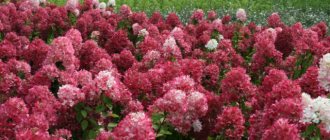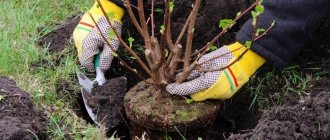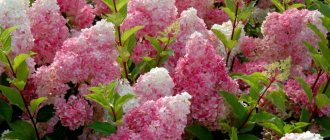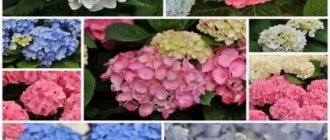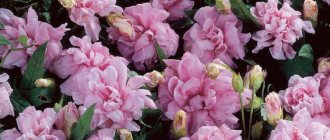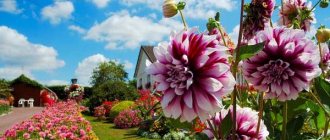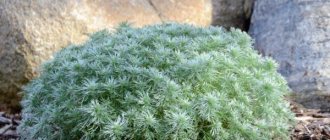Description and characteristics of the flower
In nature, there are about 80 species of Hydrangeas, and each species has characteristic, both generic and species-specific features. Mostly, representatives of this genus are shrubs from 1 to 3 meters in height, but small trees and vines are also found. The leaves of hydrangeas are large, ovoid, wavy or pointed at the edges.
Hydrangea petiolate
Hydrangea flowers are located at the ends of the stems and are collected in lush inflorescences in the form of balls, umbrellas, cones or panicles. The largest inflorescences in some species can reach 25 cm in diameter.
In a large number of species, they consist of two types of flowers: large (sterile) located in the middle and small (fruitful) flowers growing on the edges. Sometimes inflorescences are represented only by fruit flowers of the same size.
Hydrangeas have a wide color palette. You can find flowers in pink, blue, lilac and white shades. Also, palettes of several colors can be combined in one inflorescence.
The color of hydrangea petals is influenced by the nature of the soil: on acidic soils the flowers are blue, on alkaline soils they are lilac or pink, on neutral soils they are pale beige. Hydrangeas bloom for a long time, from June until late autumn.
Types and varieties of hydrangea
The most common hydrangeas in Russia are tree-like and paniculate species.
Hydrangea tree is a shrub up to 2-3 meters in height. The leaves are oval and up to 20 centimeters long. Small flowers are collected in large lush inflorescences and bloom until late autumn.
Tree-like representatives of this genus can freeze out in winter, but recover again in spring. Therefore, it is recommended to prune them every April, almost at the root, so that the old frozen branches do not interfere with the growth of new ones and do not spoil the appearance of the bush. The most popular varieties of this species include:
Hydrangea. Variety "Anabelle"
Anabel is a variety that blooms from May to October; the inflorescences are large, spherical, formed by large sterile white flowers; the flowers turn green in the fall. This variety grows well in acidic soil, loves shade and tolerates winter quite well.
Sterilis is a variety of hydrangeas characterized by rapid and prolonged flowering from July to October; the inflorescences are large, hemispherical, and the color changes from greenish-white to snow-white.
Pink Bella Anna is a variety characterized by bright pink shades of flowers. These hydrangeas adapt well to new conditions and continue to bloom until the first frost. This variety is extremely frost-resistant and does not require shelter even at -30C.
White Dom is a variety distinguished by unsurpassed white-cream inflorescences with a diameter of 25 cm, blooming from June to September, has a spreading crown and grows up to 150 cm.
"Invincible Spirit"
Invincibelle Spirit is a variety characterized by pink inflorescences. Later, the color saturation changes from dark to light. This variety is also quite unpretentious, tolerates pruning well, and recovers quickly.
Hydrangea paniculata. This species is also represented by shrubs, however, compared to the tree type, they are quite low, up to 1.5 meters in height, and their inflorescences have the shape of an extended pyramid.
Vanille Fraise
Their leaves are ovoid or elliptical in shape. The first flowers appear from June to July and bloom until late autumn.
During flowering, they can change color from white to pink, and then greenish. This species tolerates winter cold quite well. The following varieties are considered the most common:
Vanille Fraise is a variety of paniculata hydrangea, characterized by a fast growth rate, large inflorescences (up to 30 cm), as well as original color. The petals on their flowers can range from snowy white to bright crimson at the same time.
Wim'sRed is a variety with even larger conical inflorescences, reaching up to 35 cm, and they also exude an attractive honey aroma. The inflorescences change color over time: at first they are white, then pink, and in the fall they become deep red.
Grandiflora is a variety with huge panicle-type inflorescences. When they bloom, they are creamy white, snow-white in full bloom, and turn pink in late summer.
Hydrangea "Bobo"
Bobo is a relatively young variety of dwarf hydrangea, up to 70 cm high. The inflorescences are initially lemon green, turning white or pink as they bloom. They prefer shady places with moist acidic soils. This variety is often grown in containers that are placed on terraces, gardens or loggias.
Phantom
Pinky Winky is one of the best varieties of this species; it can be a shrub or small tree with a wide rounded crown that grows 30 cm annually. The inflorescence panicle is initially white, then acquires a purple tint.
Phantom is a highly prized variety with a honey aroma and luxurious inflorescences. Which are creamy in the summer and pinkish with yellow tops in the fall. The petals of these hydrangeas are somewhat different from the others: they are not so tightly arranged to each other and have a more elongated shape.
Hydrangea largeleaf
Large -leaved hydrangea is a heat-loving shrub that grows up to 2.5 meters in nature and up to 0.6 meters if grown at home. They bloom from June to October, their inflorescences are light green, blue, variegated or pink, in a wide variety of shapes.
Hydrangea oakleaf
Climbing or petiolate hydrangea is a vine with scutellum-type inflorescences. Such hydrangeas grow extremely slowly, although they can rise up to 20 meters in height, and can only take root in the southern regions.
Oakleaf hydrangea is a rather large shrub up to two meters high, the inflorescences are cone-shaped, white, and have leaves similar in texture to oak leaves, which is why they got their name. The non-frost-resistant species is suitable for cultivation only in the southern regions.
From the varieties listed above, the gardener needs to choose the one he likes, and choosing a place on the site will not cause much trouble.
Selecting a location
Ornamental, abundantly flowering crops love a lot of sun, and a site for garden hydrangeas is chosen in a sunny place, where there is shade from the sun from noon to 15.00. If you plant them in the shade or where there is partial shade for most of the day, the decorative effect will suffer - the flowers will become smaller, the color less saturated, flowering will occur later, and the plant will begin to get sick over time.
An area illuminated by the sun for less than three hours is considered shady, 4-5 hours is considered semi-shaded.
It is also necessary to take into account the direction of the winds so that the bushes do not end up in a draft. A fence, buildings, bushes, and hedges will protect from the wind, but they should not provide shade. You can’t plant it close to a building or a fence - when heated, the brick or metal will create an “oven” effect.
Related article:
Features and properties of chelate fertilizers
The characteristics of the species and variety play a large role in choosing a location. For example, in the southern regions, a semi-shaded area between bushes and trees is suitable for paniculate, tree, and large-leaved hydrangeas, but in the northwestern regions the sun is not so active, there are fewer sunny days, so planting in an open area is possible. In contrast to these species, serrate and oakleaf prefer shady places. Care for all types is the same.
Unwanted neighbors:
- black currant, herbs - the essential oils in their composition negatively affect the development of the entire plant;
- white acacia - the roots secrete substances that negatively affect the root system of the crop;
- trees and bushes with strong roots will take away moisture and nutrients from the hydrangea.
Related article:
The secret to preparing your favorite snack: 5 best varieties of watermelon for pickling for the winter
Where and when to plant hydrangea in a summer cottage
Light shade will not harm the flowering of hydrangea.
The ideal location for hydrangea would be a well-lit area with a slight shadow. This plant grows and blooms quickly in well-lit areas, however, it suffers from drying out soil from the heat. If you plant hydrangeas in the shade, the inflorescences will be smaller than those of their counterparts growing in the light.
It is worth paying attention to the properties of the soil. When planting hydrangeas, remember that alkaline or neutral types of soil are not suitable for them. In alkaline soil, the plant may have problems with flowering and suffer from chlorosis; hydrangeas and neutral soils are not suitable. Thus, the soil for planting hydrangeas should be acidic.
These plants take root well in nutritious soils containing clay and sand. Because of this, clay is sometimes added to the bottom of the pit before planting.
These plants also love moisture. In the summer, it is advisable to water them at least 1-2 times a week. Despite this, the wintering of a shrub strongly depends on the amount of moisture stored in the roots in the fall; the less moisture there is in the roots in the fall, the greater the chance that the plant will survive the winter. For this reason, in the fall the soil around the bushes is protected from precipitation.
If the question arises, when is it better to plant hydrangeas in autumn or spring? It is worth starting from the species characteristics. Tree-like and paniculate species of hydrangeas are planted in the fall at the beginning of September, as they are quite unpretentious and frost-resistant, but heat-loving large-leaved species should be planted in the spring in May, since there is still a risk of freezing.
Soil requirements
All varieties prefer loose, fertile soil, so they need to be planted in neutral, slightly acidic or acidic soils that are permeable to moisture and air, without stagnant melt water. Alkaline soil is not suitable for them. The optimal acidity level is 5-6.5.
They regulate acidity using special compounds (Acid Plus, etc.), home remedies (vinegar, citric acid), dolomite flour, sawdust, pine litter, peat, sulfur, aluminum sulfate. For example, sand and 2 kg of dolomite flour per square area are added to clayey acidic soils. Any procedures to change the composition are best carried out in the fall or 3-4 weeks before spring planting.
The color of large-leaved hydrangea flowers depends on the pH level - in neutral or slightly alkaline soil they are pink, in acidic soil they are blue or light blue.
The composition of the soil is also important, since bushes grow in one place for more than one year. Ways to change the structure and composition:
- in sandy lands where there is an insufficient amount of nutrients and humus, add compost, rotted manure or peat (40-60 kg/10 m²);
- preparation of heavy, dense soils begins a year in advance - apply a layer (10 cm) of peat or compost, pine bark, gravel and dig to a depth of 30 cm.
Related article:
Chokeberry - cultivation and beneficial properties of black chokeberry pearls
Hydrangea planting technology
You can grow your own hydrangea in different ways: grow it from seeds, plant cuttings or layering, or divide the bush.
Dividing the bush
In early spring, you can sow seeds superficially in various containers. The soil for this will be a mixture of leaf and peat soil with the addition of sand in a ratio of 4:2:1.
Containers are filled with the earth mixture, seeds are laid out on the surface of the soil and lightly sprinkled with soil. A spray bottle is used to moisten the crops. The containers are covered with glass to retain moisture and heat.
You should not forget about the crops for a long time; they require mandatory ventilation and moistening as needed. It will take 1-1.5 months for seeds to germinate. Then the cover is removed and the first picking is carried out in the cotyledon phase. The second transplant is done in May into separate pots.
Hydrangea grown from seeds is grown at home within two years. In winter they are kept in a bright and cool room, and in summer they are accustomed to fresh air - taken out onto the street or balcony.
In May, you can sow the seeds in open ground, on a high, heated bed. Shoots will appear in about a month, but such seedlings will be able to bloom no earlier than three years.
To immediately get a spectacular flowering plant, you should buy high-quality seedlings, which can be planted both in spring and autumn. In the northern regions it is recommended to plant hydrangeas in the spring, and in the southern regions this can be done in the fall.
In any case, before planting, seedlings should be slightly trimmed with roots, and spring seedlings should also be shortened with annual shoots, leaving no more than four pairs of buds on each.
The cuttings should be prepared in July by cutting the branches that thicken the crown. The lower cut of the cuttings is made beveled, and the upper cut is straight, not forgetting to leave a couple of internodes and upper leaves. Then they are rooted in fertile soil in a greenhouse or boxes. In August, they are transferred to a breeding bed or the wintering box is moved to a cool room. You can also propagate hydrangea by layering, but this is less effective.
Hydrangea seedlings can be planted in the fall only with a healthy root system.
Planting requires fertile and humus-rich soil with an admixture of clay, and an optimal acidity level of pH 5.2-6.0. Holes approximately 0.5-0.5-0.6 m in size are filled with soil mixture as for seeds, but you can also add 20 g of urea, 20-30 g of potassium sulfate and 60-70 g of superphosphate.
Seedlings are planted at a distance of 1.5-2 m from each other. After planting, the bushes are shed with warm water, approximately 8-12 liters per bush, then the tree trunk circle is mulched with sawdust, bark or peat chips.
When is the best time to plant
All varieties, be it a shrub or a vine, take a long time to take root in a new place; adaptation takes time, so you can plant, transplant and transplant hydrangeas in the garden both in spring and autumn, but taking this feature into account. The choice of timing depends on the climate of the area.
If winter comes early and autumn is cold, then it is better to plant in the spring, when the soil has warmed up, positive day and night temperatures have established, and there is no threat of frost. In most regions this period falls in mid-May, in the northern regions - at the end of the month.
Related article:
Why do seedlings rot and how to avoid it?
In a climate with a long and warm autumn, the root system will have time to take root before the cold weather, so autumn planting is possible. The young plant will enter winter with strong roots and, under good shelter, will withstand the cold without loss.
In summer, planting is also possible, but only if the weather is cool, not hot, or shading can be created so that the soil does not overheat and the plant does not suffer from sunlight. It is difficult to create such conditions in the summer season and most people prefer spring and autumn planting. If there are no options, then choose the period until mid-June.
Caring for a plant in open ground
Hydrangeas are extremely moisture-loving, so in summer they should be watered weekly, about 15-20 liters of water per bush. In rainy summers, watering is reduced to 3-5 times per season. To enhance the strength of the shoots, add a couple of drops of potassium permanganate.
In addition to watering, it is necessary to weed and loosen the soil to a depth of 5-7 cm.
If the hydrangea was planted in fertile soil, then for the first couple of years they do not need to be fed. Then every year it is advisable to fertilize: in the spring - with complex mineral fertilizer 30g per 10 liters of water; during the budding period - 60 g of superphosphate and 40 g of potassium sulfate per square meter, and twice during the summer - with mullein solution.
Landing rules
The planting site, regardless of the species and variety, is prepared in the same way. In fertile areas, the top layer of soil is set aside when digging a hole - it will be needed. If the soil is light and sandy, then remove all the soil from the hole and use the prepared nutritious soil mixture, adding soil from the garden or another area.
How to plant hydrangea correctly:
- dig a hole, depth and diameter - 45-55 cm, the distance between the holes depends on the size of the adult bush and the planting pattern;
- if the soil is dense and heavy, then lay a layer (10 cm) of drainage made of expanded clay, pebbles, broken bricks;
- mix the soil from the top layer with rotted manure, leaf soil, sand (take everything in equal parts);
- add 2 tbsp. superphosphate, 1.5 tbsp. l. potassium sulfate, ¼ bucket of wood ash, mix (add 1 cup of dolomite flour to acidic soil);
- pour a layer of prepared soil onto the drainage, place the seedling in the center in a lump of earth, cutting off long roots if necessary, fill in the voids, water, using 1.5-2 buckets per bush (the lump is watered in advance - then it will not crumble when removed from the container) ;
- build sides around the seedling to prevent water from spreading, apply mulch from sawdust, peat, pine bark, or a mixture of several components;
- Instead of mulching, you can plant ground covers (ivy, periwinkle, apical pachysandra).
Related article:
Preparing the right beds for winter garlic
Preparing for winter
Hydrangea paniculata
Varieties of paniculata and tree hydrangeas tolerate winter well, but it would be a good idea to protect their roots.
Why they can be sprinkled with peat, dry leaves, or covered with spruce branches.
However, large-leaved species are more thermophilic. Therefore, immediately after the end of leaf fall, the branches should be carefully tilted towards the ground, placing spruce branches under them. The top of the branches should also be covered with spruce branches or leaves. In spring, the protective layer is gradually removed without exposing the bush to stress from temperature fluctuations.
If there are a lot of slugs in the garden plot, then before covering the soil around the hydrangeas should be sprinkled with pine needles or spilled with specialized preparations, for example “Slug Eater”. Otherwise, young shoots will suffer in the spring.
Pests and diseases, their control
Hydrangeas are fairly resilient plants, but they still have several pests that can cause severe harm to the plant. These include: green leaf aphids, downy mildew, spider mites and chlorosis.
aphids in closed ground during forcing. A good remedy for them is considered to be a solution of anabasine sulfate, which is dissolved in a proportion of 20 g per 10 liters of water and the bush is treated twice.
If a plant is affected by powdery mildew, spots appear on the leaves, initially oily
Hydrangea diseases
then yellow, which enlarge and darken over time. Plaque can also spread to young stems. The development of this scourge is favored by excessive air humidity and temperatures around 18-20 C. In this case, treating the plant with a solution containing 15 g of copper sulfate and 150 green soap diluted in 10 liters of water will help.
If yellowing or marbling appears on the undersides of the leaves, your plant is infested with spider mites. The leaves affected by it will soon dry out and fall off.
This pest thrives at a temperature of about 30 C and a humidity of 40-55%. Treating the leaves with thiophos will help you fight it. To do this, you need to dissolve about 7 g of the drug in 10 liters of water and treat the plant with the resulting solution.
Another problem for hydrangeas is chlorosis. When the disease affects the plant, the leaves become lighter and dark veins stand out on them. As a rule, plants growing on limestone or if the soil is oversaturated with humus are susceptible to this disease. To rid the plant of chlorosis, you need to water the bushes a couple of times with a solution of potassium nitrate (40 g per 10 liters of water), and after 3 days, shed it with a solution of iron sulfate in the same proportions.
It is also worth noting that if there is a lack of water, the tips of the leaves of the plant dry out, and if there is a lack of nutrients, the plant develops poorly and does not bloom.
Caring for hydrangea in the first year of planting
Caring for a perennial crop is simple. The most important thing is to systematically moisten the soil. It is recommended to pour 35-50 liters of water at room temperature under each bush. The frequency of watering in the warm season is every 2-3 days. If the tree trunk circle is mulched, then the frequency of watering is reduced to once every 5-7 days. To improve the aeration of the root system, you should systematically loosen the soil around the bushes. How deep should it be? The recommended depth is 45-55 mm.
Fading buds must be trimmed promptly.
To achieve abundant and long-lasting flowering, flower growers recommend applying complex fertilizing every spring and summer. In mid-April, a urea solution is added to the soil (20-22 g of the component is mixed in a bucket of settled rainwater). You will need to pour several buckets of this solution under each adult bush.
After the plant has flowered, complex mineral fertilizer should be added to the soil. Throughout the summer, slurry is poured under the bushes. However, here it is important not to overdo it with the volume of fertilizing, because inflorescences that are too large will break fragile shoots. To prevent branches from breaking off, it is recommended to control the amount of fertilizer applied to the soil and tie up the shoots.
Pruning hydrangea
Hydrangeas that have reached 4-5 years of age require systematic pruning. Varieties that bloom on the branches of the current year should be pruned in early spring before the buds open and sap flow begins. Otherwise, the plant will bleed and die. In order not to miss pruning time, you should pay attention to the appearance of the buds. As soon as they swell and take on a revived appearance, you can begin the procedure.
As a rule, the first pruning is carried out on tree-type hydrangeas, which are characterized by early awakening. Long shoots are pruned at a height of 4 buds. The cut parts of the shoots can be used as cuttings.
When pruning the paniculate type of globular perennial, you should be careful. Last year's branches are pruned by only a third. Even such small parts can be used as cuttings.
The large-leaved perennial requires almost no pruning. It is enough just to systematically carry out anti-aging pruning, removing dried or broken shoots and branches growing inside the bush.
Caring for hydrangea after flowering and preparing for winter
After a perennial crop has flowered, it is worth cutting off the inflorescences that have wilted. The bases of the bushes are hilled high, the area is mulched, which makes it possible to organize the protection of plants from severe frosts.
The paniculate type and ground cover type of ornamental crop are considered to be the most resistant to cold weather.
Lignified shoots can withstand frost even without shelter, if, of course, the shrub is planted in the southern regions. However, it is better not to take risks and take care in advance of preparing hydrangea for a harsh winter:
- In mid-autumn, young bushes are covered with a layer of dry soil. Branches of plants older than 3 years bend to the ground surface.
- The shoots are covered with a layer of lutrasil. The material is fixed at the edges with bricks, which will prevent the material from being torn off by gusts of wind.
- Mature shrubs are carefully tied with twine and wrapped in a layer of lutrasil or spandbond. A cylindrical frame is built around the bush. To construct it, you can use a metal mesh. The distance from the net to the bush should be within 22-25 cm. The height of the structure should exceed the height of the perennial by 10-12 cm. The area from the hydrangea to the net is filled with dry foliage. It will be possible to remove the shelter only at the end of March, when the frosts have passed.
Hydrangea in landscape design
Hydrangea looks amazing in pots.
Hydrangea has a fairly long flowering period and large, bright inflorescences, which makes it an advantageous flower base for creating a landscape composition. This shrub can transform a garden, either when planted alone or in groups.
Hydrangeas are planted in the entrance area, in the middle of flower meadows, and used to create a hedge. It can also transform the view of a gazebo or any other building in the garden. Large multi-colored varieties of large-leaved hydrangea fit perfectly into flower beds.
To create romantic notes in your garden, you can use varieties of paniculata and tree hydrangea; they go well with sedum, mantle, phlox, knotweed and lilac. And petiole hydrangea will help to embellish the look of a house or gazebo. It is worth noting that hydrangeas thrive in pots, tubs and containers, which can be taken outside in the summer and hidden in the house or greenhouse in the winter.
Diseases and pests
Hydrangea is quite resistant to pest attacks, but sometimes, if not properly cared for, it can be affected by spider mites, aphids and even ants, which easily spread from other “green neighbors”. Traditional methods and treatment with special insecticides help in pest control .
Diseases that can cause trouble are chlorosis, gray and white rot, powdery mildew, septoria and rust. If signs of disease are detected, damaged parts of the plant are removed and treated with specialized preparations.
Timely preventive measures to care for hydrangea are the key to its health and beauty
In the garden, blooming hydrangea can become a real decoration. If you provide the plant with proper care and attention, it will fill the space with the aroma of its flowers every year. Hydrangea looks great in solo or group planting and will be an excellent option for decorating various compositions with herbaceous, coniferous and other flowering shrubs and trees. It can be planted in the center of a large flower bed or surrounded by a lawn - in any case, the hydrangea will look great.
Author of the article: Polina Viktorovna Kolesnikova
- Related Posts
- How to arrange a Japanese garden on your site - landscape tricks, planning tips (photos)
- Layout of a summer cottage plot of 6 acres: ideas, tips, tips for arrangement
- 38 of the most unpretentious long-flowering perennials for growing in country flower beds
« Previous entry
